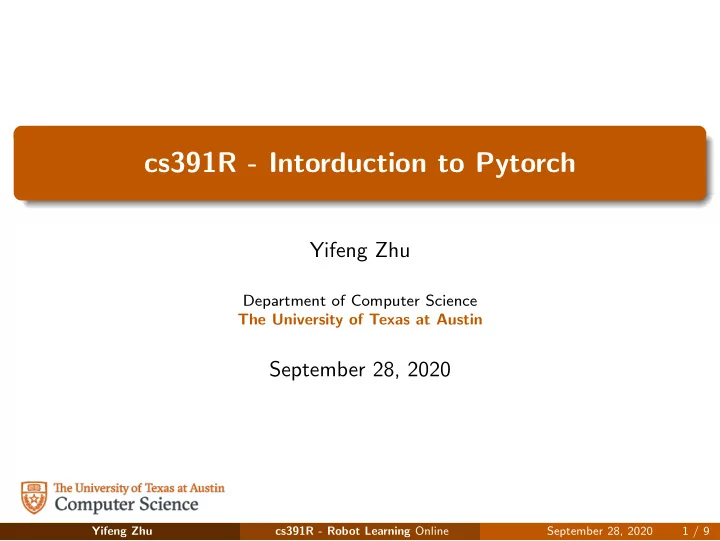

cs391R - Intorduction to Pytorch Yifeng Zhu Department of Computer Science The University of Texas at Austin September 28, 2020 cs391R - Robot Learning Online September 28, 2020 1 / 9 Yifeng Zhu
Disclaimer: Adopted from gatech tutorial: Link cs391R - Robot Learning Online September 28, 2020 2 / 9 Yifeng Zhu
Why PyTorch?
Tensors Tensors are similar to NumPy’s ndarrays, with the addition being that Tensors can also be used on a GPU to accelerate computing. Common operations for creation and manipulation of these Tensors are similar to those for ndarrays in NumPy. (rand, ones, zeros, indexing, slicing, reshape, transpose, cross product, matrix product, element wise multiplication)
Tensors Attributes of a tensor 't': ● t= torch.randn(1) requires_grad - making a trainable parameter ● By default False ● Turn on: ○ t.requires_grad_() or ○ t = torch.randn(1, requires_grad=True) ● Accessing tensor value: ○ t.data ● Accessingtensor gradient ○ t.grad grad_fn - history of operations for autograd ● t.grad_fn
Loading Data, Devices and CUDA Numpy arrays to PyTorch tensors Fallback to cpu if gpu is unavailable: ● torch.from_numpy(x_train) ● torch.cuda.is_available() ● Returns a cpu tensor! Check cpu/gpu tensor OR numpyarray ? PyTorchtensor to numpy ● type(t) or t.type() returns ● ○ numpy.ndarray t.numpy() ○ torch.Tensor Using GPU acceleration ■ CPU - torch.cpu.FloatTensor ■ GPU - torch.cuda.FloatTensor ● t.to() ● Sends to whatever device (cudaor cpu)
Autograd ● Automatic Differentiation Package ● Don’t need to worry about partial differentiation, chain rule etc. ○ backward() does that ● Gradients are accumulated for each step by default: ○ Need to zero out gradients after each update ○ tensor.grad_zero()
Optimizer and Loss Optimizer ● Adam, SGD etc. ● An optimizer takes the parameters we want to update, the learning rate we want to use along with other hyper-parameters and performs the updates Loss ● Various predefined loss functions to choose from ● L1, MSE, Cross Entropy
Model In PyTorch, a model is represented by a regular Python class that inherits from the Module class. ● Two components ○ __init__(self): it defines the parts that make up the model- in our case, two parameters, a and b ○ forward(self, x) : it performs the actual computation, that is, it outputs a prediction, given the inputx
Model Two-layer neural network with ReLU activation function, and Sigmoid activation for the output.: class TwoLayerNetwork(nn.Module): def __init__(self, input_dim=2, hidden_dim=128, output_dim=1): self.input_dim = input_dim self.hidden_dim = hidden_dim self.output_dim = output_dim self.layers = nn.Sequential([nn.Linear(input_dim, hidden_dim), nn.ReLU(), nn.Linear(hidden_dim, output_dim), nn.Sigmoid()]) def forward(self, x): return self.layers(x) cs391R - Robot Learning Online September 28, 2020 3 / 9 Yifeng Zhu
Create custom dataset I class CustomDataset(torch.utils.data.Dataset): def __init__(self, file_path, root_dir, transform=None): self.data = LOAD_DATA_FUNC(file_path) self.root_dir = root_dir self.transform = transform def __len__(self): return len(self.data) def __getitem__(self, idx): if torch.is_tensor(idx): idx = idx.tolist() cs391R - Robot Learning Online September 28, 2020 4 / 9 Yifeng Zhu
Create custom dataset II # Load image img_name = os.path.join(self.root_dir, self.data[idx, 0]) img = io.imread(img_name) label = self.data[idx, 1] sample = {‘image’: img, ‘label’: label} if self.transform: sample = self.transform(sample) return sample cs391R - Robot Learning Online September 28, 2020 5 / 9 Yifeng Zhu
Example of training I Safely enable gpu GPU_AVAILABLE = torch.cuda.is_available() def enable_cuda(x): if GPU_AVAILABLE: return x.cuda() return x cs391R - Robot Learning Online September 28, 2020 6 / 9 Yifeng Zhu
Example of training II Initialization before training dataset = CustomDataset(dataset_path) loader = CustomDataLoader(dataset, batch_size=32, shuffle=True, num_workers=1) network = CustomNetwork(input_dim, output_dim, hidden_dim, ...) optimizer = torch.optim.Adam(network.parameters(), lr=lr) criterion = torch.nn.BCEWIthLogitsLoss() network = enable_cuda(network) criterion = enable_cuda(criterion) cs391R - Robot Learning Online September 28, 2020 7 / 9 Yifeng Zhu
cs391R - Robot Learning Online September 28, 2020 8 / 9 Yifeng Zhu
Training for-loop for epoch in range(n_epoch): for data in loader: # x, label in data are defined in the custom dataLoader predicted_y = network(enable_cuda(data.x.float())) target = enable_cuda(data.label.float()) loss = criterion(predicted_y, target) optimizer.zero_grad() # Compute gradients for backpropagation loadd.backward() # Do backpropagation optimizer.step() # Save the network torch.save(network.state_dict(), path_to_save) cs391R - Robot Learning Online September 28, 2020 9 / 9 Yifeng Zhu
Recommend
More recommend